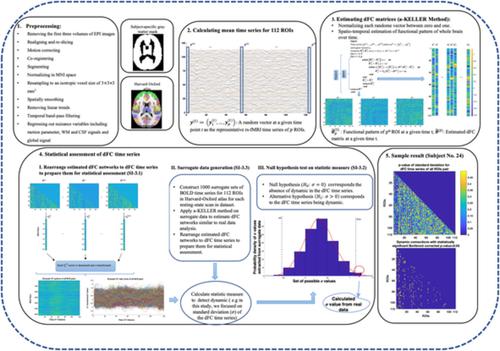当前位置:
X-MOL 学术
›
Hum. Brain Mapp.
›
论文详情
Our official English website, www.x-mol.net, welcomes your
feedback! (Note: you will need to create a separate account there.)
Improved dynamic connection detection power in estimated dynamic functional connectivity considering multivariate dependencies between brain regions.
Human Brain Mapping ( IF 3.5 ) Pub Date : 2020-07-09 , DOI: 10.1002/hbm.25124 Somayeh Maleki Balajoo 1 , Davud Asemani 1 , Ali Khadem 1 , Hamid Soltanian-Zadeh 2, 3, 4
Human Brain Mapping ( IF 3.5 ) Pub Date : 2020-07-09 , DOI: 10.1002/hbm.25124 Somayeh Maleki Balajoo 1 , Davud Asemani 1 , Ali Khadem 1 , Hamid Soltanian-Zadeh 2, 3, 4
Affiliation

|
To estimate dynamic functional connectivity (dFC), the conventional method of sliding window correlation (SWC) suffers from poor performance of dynamic connection detection. This stems from the equal weighting of observations, suboptimal time scale, nonsparse output, and the fact that it is bivariate. To overcome these limitations, we exploited the kernel‐reweighted logistic regression (KELLER) algorithm, a method that is common in genetic studies, to estimate dFC in resting state functional magnetic resonance imaging (rs‐fMRI) data. KELLER can estimate dFC through estimating both spatial and temporal patterns of functional connectivity between brain regions. This paper compares the performance of the proposed KELLER method with current methods (SWC and tapered‐SWC (T‐SWC) with different window lengths) based on both simulated and real rs‐fMRI data. Estimated dFC networks were assessed for detecting dynamically connected brain region pairs with hypothesis testing. Simulation results revealed that KELLER can detect dynamic connections with a statistical power of 87.35% compared with 70.17% and 58.54% associated with T‐SWC (p‐value = .001) and SWC (p‐value <.001), respectively. Results of these different methods applied on real rs‐fMRI data were investigated for two aspects: calculating the similarity between identified mean dynamic pattern and identifying dynamic pattern in default mode network (DMN). In 68% of subjects, the results of T‐SWC with window length of 100 s, among different window lengths, demonstrated the highest similarity to those of KELLER. With regards to DMN, KELLER estimated previously reported dynamic connection pairs between dorsal and ventral DMN while SWC‐based method was unable to detect these dynamic connections.
中文翻译:

考虑到大脑区域之间的多变量依赖关系,在估计的动态功能连接中提高了动态连接检测能力。
为了估计动态功能连接(dFC),传统的滑动窗口相关(SWC)方法存在动态连接检测性能差的问题。这源于观察的相等权重、次优时间尺度、非稀疏输出以及它是双变量的事实。为了克服这些限制,我们利用核重加权逻辑回归 (KELLER) 算法(一种在遗传研究中常见的方法)来估计静息状态功能磁共振成像 (rs-fMRI) 数据中的 dFC。KELLER 可以通过估计大脑区域之间功能连接的空间和时间模式来估计 dFC。本文基于模拟和真实 rs-fMRI 数据比较了所提出的 KELLER 方法与当前方法(具有不同窗口长度的 SWC 和锥形 SWC (T-SWC))的性能。评估了估计的 dFC 网络,以通过假设检验检测动态连接的大脑区域对。模拟结果表明,KELLER 可以检测到动态连接,统计功效为 87.35%,而与 T-SWC 相关的统计功效分别为 70.17% 和 58.54%(p值 = .001) 和 SWC ( p值 <.001)。这些不同方法应用于真实 rs-fMRI 数据的结果从两个方面进行了研究:计算识别的平均动态模式之间的相似性和识别默认模式网络 (DMN) 中的动态模式。在 68% 的受试者中,窗口长度为 100 s 的 T-SWC 结果在不同窗口长度中与 KELLER 的结果相似度最高。关于 DMN,KELLER 估计了先前报道的背侧和腹侧 DMN 之间的动态连接对,而基于 SWC 的方法无法检测到这些动态连接。
更新日期:2020-07-09
中文翻译:

考虑到大脑区域之间的多变量依赖关系,在估计的动态功能连接中提高了动态连接检测能力。
为了估计动态功能连接(dFC),传统的滑动窗口相关(SWC)方法存在动态连接检测性能差的问题。这源于观察的相等权重、次优时间尺度、非稀疏输出以及它是双变量的事实。为了克服这些限制,我们利用核重加权逻辑回归 (KELLER) 算法(一种在遗传研究中常见的方法)来估计静息状态功能磁共振成像 (rs-fMRI) 数据中的 dFC。KELLER 可以通过估计大脑区域之间功能连接的空间和时间模式来估计 dFC。本文基于模拟和真实 rs-fMRI 数据比较了所提出的 KELLER 方法与当前方法(具有不同窗口长度的 SWC 和锥形 SWC (T-SWC))的性能。评估了估计的 dFC 网络,以通过假设检验检测动态连接的大脑区域对。模拟结果表明,KELLER 可以检测到动态连接,统计功效为 87.35%,而与 T-SWC 相关的统计功效分别为 70.17% 和 58.54%(p值 = .001) 和 SWC ( p值 <.001)。这些不同方法应用于真实 rs-fMRI 数据的结果从两个方面进行了研究:计算识别的平均动态模式之间的相似性和识别默认模式网络 (DMN) 中的动态模式。在 68% 的受试者中,窗口长度为 100 s 的 T-SWC 结果在不同窗口长度中与 KELLER 的结果相似度最高。关于 DMN,KELLER 估计了先前报道的背侧和腹侧 DMN 之间的动态连接对,而基于 SWC 的方法无法检测到这些动态连接。











































 京公网安备 11010802027423号
京公网安备 11010802027423号